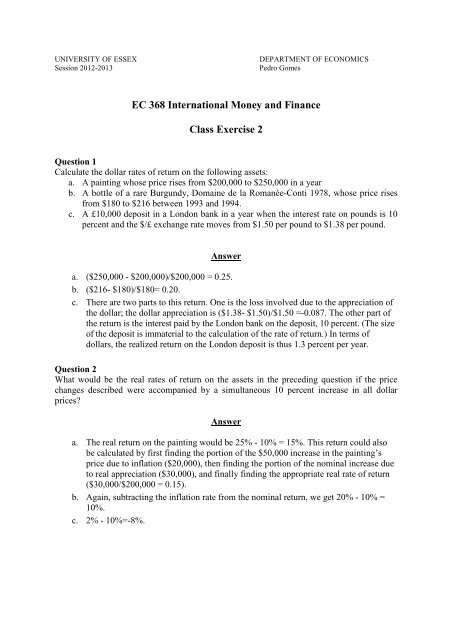EC 368 International Money and Finance Class Exercise 2
EC 368 International Money and Finance Class Exercise 2
EC 368 International Money and Finance Class Exercise 2
Create successful ePaper yourself
Turn your PDF publications into a flip-book with our unique Google optimized e-Paper software.
UNIVERSITY OF ESSEX DEPARTMENT OF <strong>EC</strong>ONOMICS<br />
Session 2012-2013 Pedro Gomes<br />
<strong>EC</strong> <strong>368</strong> <strong>International</strong> <strong>Money</strong> <strong>and</strong> <strong>Finance</strong><br />
<strong>Class</strong> <strong>Exercise</strong> 2<br />
Question 1<br />
Calculate the dollar rates of return on the following assets:<br />
a. A painting whose price rises from $200,000 to $250,000 in a year<br />
b. A bottle of a rare Burgundy, Domaine de la Romanée-Conti 1978, whose price rises<br />
from $180 to $216 between 1993 <strong>and</strong> 1994.<br />
c. A £10,000 deposit in a London bank in a year when the interest rate on pounds is 10<br />
percent <strong>and</strong> the $/£ exchange rate moves from $1.50 per pound to $1.38 per pound.<br />
Answer<br />
a. ($250,000 - $200,000)/$200,000 = 0.25.<br />
b. ($216- $180)/$180= 0.20.<br />
c. There are two parts to this return. One is the loss involved due to the appreciation of<br />
the dollar; the dollar appreciation is ($1.38- $1.50)/$1.50 =-0.087. The other part of<br />
the return is the interest paid by the London bank on the deposit, 10 percent. (The size<br />
of the deposit is immaterial to the calculation of the rate of return.) In terms of<br />
dollars, the realized return on the London deposit is thus 1.3 percent per year.<br />
Question 2<br />
What would be the real rates of return on the assets in the preceding question if the price<br />
changes described were accompanied by a simultaneous 10 percent increase in all dollar<br />
prices?<br />
Answer<br />
a. The real return on the painting would be 25% - 10% = 15%. This return could also<br />
be calculated by first finding the portion of the $50,000 increase in the painting’s<br />
price due to inflation ($20,000), then finding the portion of the nominal increase due<br />
to real appreciation ($30,000), <strong>and</strong> finally finding the appropriate real rate of return<br />
($30,000/$200,000 = 0.15).<br />
b. Again, subtracting the inflation rate from the nominal return, we get 20% - 10% =<br />
10%.<br />
c. 2% - 10%=-8%.
Question 3<br />
Suppose the dollar interest rate <strong>and</strong> the pound sterling interest rate are the same, 3 percent per<br />
year. What is the relation between the current equilibrium $/£ exchange rate <strong>and</strong> its expected<br />
future level? Suppose the expected future $/£ exchange rate, $1. $1.52 52 per pound, remains<br />
constant as Britain’s interest rate rises to 7 percent pper<br />
r year. If the U.S. interest rate also<br />
remains constant, t, what is the new equilibrium $ $/£ exchange rate?<br />
Answer<br />
The uncovered interest rate parity can be expressed as:<br />
$ £ ]<br />
Where ( $ £ ) the dollar interest rate, ) the pound sterling interest rate, 1 the future expected<br />
exchange rate between the dollar <strong>and</strong> the pound, <strong>and</strong> the current equilibrium exchange<br />
rate.<br />
The current equilibrium exchange rate ( ) must equal its expected future level ( 1) since,<br />
$ £ with equality of nominal interest rates, ) there can be no expected increase or decrease<br />
in the dollar/pound exchange rate in equilibrium. If the expected exchange rate rem remains at<br />
$1.52 per pound <strong>and</strong> the e pound interest rate rises to 7 percent, then interest parity is satisfied<br />
only if the current exchange rate changes such that there is an expected appre appreciation of the<br />
dollar equal to 4 percent. This will occur when the excha exchange nge rate rises to $1. $1.583 per pound (a<br />
depreciation of the dollar against the pound).<br />
Question 4<br />
Traders in asset markets suddenly learn that the interest rate on dollars will decline in the near<br />
future. Use diagrammatic analysis to determine th the effect on the current dollar/euro exchange<br />
rate, assuming current interest rates on dollar <strong>and</strong> euro deposits do not change.<br />
Answer<br />
If market traders learn that the dollar interest rate will soon fall, they also revise upward their<br />
expectation of the dollar’s future depreciation in the foreign foreign-exchange exchange market. Given the<br />
current exchange rate <strong>and</strong> interest rates, there is thus a rise in the expected dollar return on<br />
euro deposits. The downward downward-sloping sloping curve in the diagram below shifts to the right <strong>and</strong> there<br />
is an n immediate dollar depreciation, as shown in the figure below where a shift in the interest interestparity<br />
curve from II to I′I′ leads to a depreciation of the dollar from E0 to EE1.
Question 5<br />
In October 1979, the U.S central bank (the Federal Reserve System) announced it would play<br />
a less active role in limiting fluctuations in dollar interest rates. After this new policy was put<br />
into effect, the dollar’s exchange rate against foreign currencie currencies s became more volatile. Does<br />
our analysis of the foreign exchange market suggest any connection between these two<br />
events?<br />
Answer<br />
Greater fluctuations in the dollar interest rate lead directly to greater fluctuation fluctuations in the<br />
exchange rate using our model described in the lectures. . The movements in the interest rate<br />
can be investigated by shifting the vertical interest rate curve. As shown in the Figure below,<br />
these movements lead directly to movements in the exchange rate. For example, an increase iin<br />
the interest rate from i to i′ leads to a dollar appreciation from E to E′. . A decrease in the<br />
interest rate from i to i″ leads to a dollar depreciation from E to E″. This diagram<br />
demonstrates the direct link between interest rate volatility <strong>and</strong> exchange rate volatility, given<br />
that the expected future exchange rate does not change.<br />
*****
















